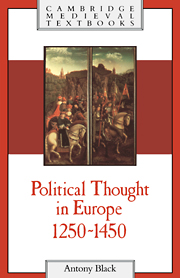Summary
Europe during the high and later Middle Ages and Renaissance experienced a particular kind of diversity and a particular kind of unity. The population had grown significantly; agriculture, commerce and manufacture had expended dramatically. It was a society full of change and innovation. Linguistically people were divided up by the vernacular speech of everyday life and law, and united by the Latin of religion, philosophy, diplomacy and higher adminstration. There were points of separate evolution within a common culture: the Netherlands and Italy, England and France were more distinct in 1450 than they had been in 1250. Political societies and forms of government were in flux. Papacy and Empire stood for unity and the name of Rome; local customs, group allegiances and individual rights varied almost endlessly. Balances of power began to emerge in inter-state relations. France and England were becoming centralised national kingdoms. The Swiss and the Scots were fighting for independence. The German Empire was dissolving into a very loose confederation of feudal-princely territories and, on the other hand, commercial urban communities. While the feudal monarchies of Castile and Aragon reconquered Spain from the Muslims, in the Low Countries, northern Italy and the Rhineland merchants, artisans and day-labourers organised themselves into city-states and guilds. Free cities like Florence, Cologne and Ghent revolved from oligarchy to democracy and back. In England parliament was becoming partner to the Crown.
- Type
- Chapter
- Information
- Political Thought in Europe, 1250–1450 , pp. 1 - 13Publisher: Cambridge University PressPrint publication year: 1992



